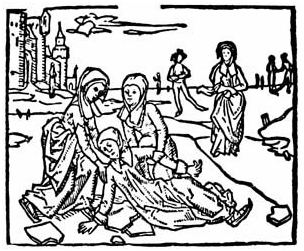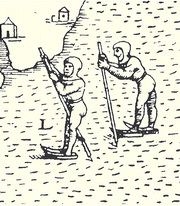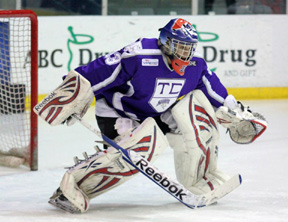Ice Skates
We know that the game of ice hockey
evolved from field hockey. We know that the first mechanically refrigerated
ice rink was built in 1876. But what do we know about ice skates?
The
first steel bladed skates were developed in 1867. But what kind of skates
were used before that?
Bone
Archeological digs have revealed that the first
ice skates were made of bones. Leather thongs laced through holes in the
front and back ends of the bones were used to tie them to the bottoms of the
shoes. The front end of the bone was shaped into a wedge to pass more easily
over rough and irregular ice.
Usually metatarsal bones of cattle or
horses were used. Metatarsals are toe bones. Hoofed animals develop strong
ones, especially the third bone of horses foot which is connected to the
hoof. These bone skates are only about 8” long.
The first skates were
probably used in about 3,000 B.C. in southern Finland. This area has a
larger concentration of small lakes than anywhere else in the world. It was
easier to skate across them than to walk around them in the winter.
Conserving energy in that cold climate was essential.
The skaters probably propelled themselves with sticks. Modern day
experiments have shown that the most efficient way is to use one stick to
push between the legs rather than using one or two sticks on the side like
ski poles. A skater on bone skates would travel about five miles per hour.
By comparison, modern day speed skaters reach speeds up to 37 miles per
hour.
One of the most well known examples of bone skates is the pair
found at Birka in the vicinity of Stockholm, Sweden. It dates from the 9th
century.

This is a sketch of the Birka. A string or cord would be pulled through the
holes at each end and then be tied around the foot. Experiments have shown
that the bone stays on tighter if the back cord is wrapped around the ankle
before it is tied.
 |
These bone skates are on exibit in the
Skogar Museum in Iceland.
"Skógar Museum was founded in 1949
and preserves the cultural heritage of South Iceland in the form of
tools and equipment used at land and sea, crafts and old buildings."
http://safnabokin.is/museum/skogar-museum/
|
http://june2010.plamoney.com/hockey/?OVRAW=midwest%20elite%20hockey%20league&OVKEY=hockey%20league&OVMTC=advanced&OVADID=37844398521&OVKWID=296107804521&OVCAMPGID=6435115521&OVADGRPID=15422335909&OVNDID=ND2
http://www.valhs.org/history/articles/daily_living/text/ice_skates.htm
http://news.bbc.co.uk/2/hi/technology/7159057.stm
http://www.timesonline.co.uk/tol/news/science/article3090363.ece
The ice skates made of bone were used throughout northern Europe.
Archeologists have found evidence in Switzerland and Holland as well as in
the Scandinavian countries. When were the bones replaced with some other
materials?
From Wood to Metal
Sometime during the 1300’s the Dutch began using a wood platform covered
with metal. No drawings or sketches have been found from that period so we
don’t know exactly what it looked like. They were only described as “wooden
platform skates with flat iron bottom runners.” Skaters were still using
poles to push themselves along.
The Patron Saint of Ice Skating

The World's Oldest Known Skating Image
In 1396 Lydwine (also Ludwina and Lidwina), a beautiful 16 year old girl,
from Schiedam in Holland was visited by friends, who invited her to go
skating. Legend says that Lydwine's friends insisted that she go skating
even though she said she wasn't feeling well. Once they were on the ice
Lydwine was knocked down. She broke 6 ribs and was bedridden for the rest of
her life. After the accident Lydwine had visions and was given credit for
performing many miracles. Lydwine was canonized in 1890 and was named the
Patron Saint of Skating in 1944. This image of the fateful fall was made in
1498 by the Dutch artist, Johannes Brugman. This image provided courtesy of
the SchaatsMuseum (Netherlands).
from <http://www.icesk8.com/clipart7.htm>
About 1500 the Dutch added narrow, metal double blades under the wood
platform. These made it possible to discard the poles and push oneself along
in what was called the “Dutch roll.” As blacksmithing evolved the iron was
replaced by steel.
 |
This 1539 map of Sweden features the first images of ice skaters.
Notice how they are pushing themselves along with poles. The bottoms
of the poles have sharp points set in them to grab the ice. |
| |
|
Metal Ice Skates
A St. Paul, MN blade maker,
John Strauss, curved the skate blade up to invent the closed toe blade in
1914. This made the skates stronger and lighter. Now skaters could do more
tricks on skates like quadruple jumps.

Curved blade with a figure skating toe pick
Hockey Skates
Skates are the most important pieces of any hockey player’s equipment. There
are only two types of hockey skates, player and goalie. The player skates
have a stiffer boot and shorter blade than the goalie skate. The stiff boot
provides more protection, but a puck to the ankle or instep still hurts and
leaves a bruise. The softer goalie boot allows for more ankle movement. The
shorter blade allows the player to skate faster. A goalie does not need the
speed but a longer blade allows for better movement within the crease.
As far as fit is concerned,
it depends on what the player prefers. Some players want a looser skate and
softer boot. Another player may want a tighter, stiffer boot. In either case
they want a boot that fits tight around the ankle to prevent injury from
twisting.
Skates are
expensive. Junior and youth skates might be found for under $200. The
intermediate price range for skates is $250-$400. Elite skates will cost
anywhere from $450 to $600. While the more expensive skates may be stiffer,
they may not be the best skate in other ways. [2010 prices]
No matter what the price, brand new skates do not fit perfectly. The memory
foam on the inside of the skate will conform to the foot with use but that
takes time. A quicker way is to bake the skates.
While a conventional oven is heating to 180° the insoles of the new skates
should be removed and the skates laced up lightly. Put the skates on a
cookie sheet, turn off the oven, and put the skates in for 8 to 10 minutes.
When the skates are soft and pliable, put the insoles back in and put the
skates on being careful not to touch any metal parts. The heels need to be
pushed firmly into the back of the skate by tapping the heel on the floor.
When tightening the laces they should be pulled outward instead of upward so
the metal eyelets are not loosened. Running hand over the boot will press it
into shape around the feet. Then the skater should just sit there for about
10 to 15 minutes while the skates cool in the shape of his/her feet.
Baking Skates
While a
conventional oven is heating to 180° the insoles of the new skates should be
removed and the skates laced up lightly. Put the skates on a cookie sheet,
turn off the oven, and put the skates in for 8 to 10 minutes.
When the skates are soft and pliable, put the insoles back in and put the
skates on being careful not to touch any metal parts. The heels need to be
pushed firmly into the back of the skate by tapping the heel on the floor.
When tightening the laces
they should be pulled outward instead of upward so the metal eyelets are not
loosened. Running hands over the boot will press it into shape around the
feet. Then the skater should just sit there for about 10 to 15 minutes while
the skates cool in the shape of his/her feet.
inventors.about.com/library/inventors/bliceskates.htm
stickshack.com - History of Ice Skates
www.livestrong.com/article/96093-comparison-hockey-skates/
www.ehow.com/how_5051948_bake-ice-hockey-skates.html
Keeping an Edge
The bottom of a modern ice skate blade, unlike the blade of a knife, has a
crescent-shaped hollow, creating two sharp edges on each skate. Ideally, the
two edges of a blade are parallel, but poor maintenance practices, such as
improper sharpening or lack of consistent sharpening, can often result in
oblique edges. These "bad" edges can affect skating ability significantly.
The depth of this hollow
is known as the Radius of Hollow (RoH). The Radius of Hollow is typically
between 1/4" and 1" depending on the type of skates and the user. The
optimal depth depends on factors such as the skater's weight, ability,
strength, sporting activity, and (for ice hockey) style of play.
The skater uses these edges in different combinations in order to maneuver.
When ice skates are sharpened the blade is ground with a stone with a curved
surface, dressed to either restore the hollow or provide a different radius.
Speed skates and touring
skates, however, have a completely flat bottom. There is no hollow, only a
squared off bottom with 2 edges. This improves glide time by not cutting
into the ice.
http://en.wikipedia.org/wiki/Ice_skate#cite_note-0
|
|

